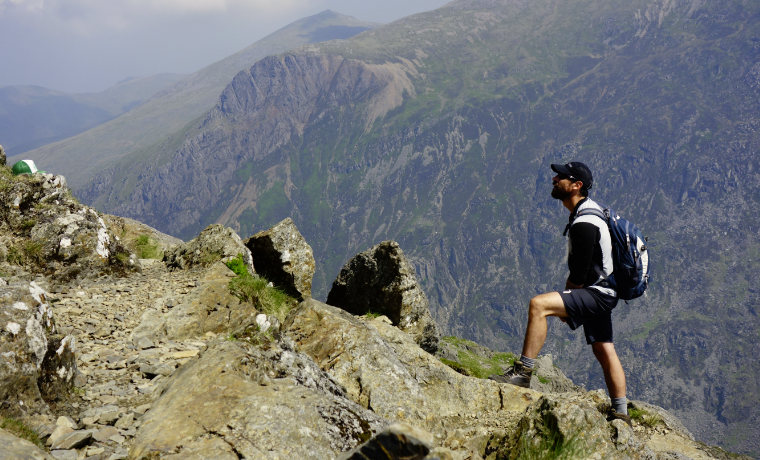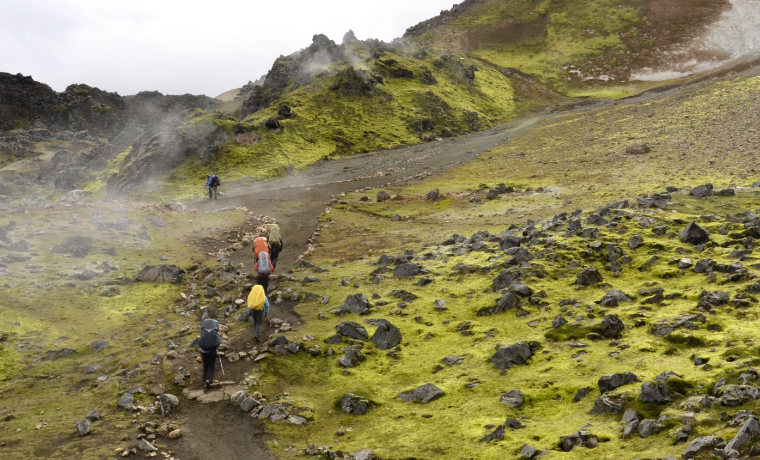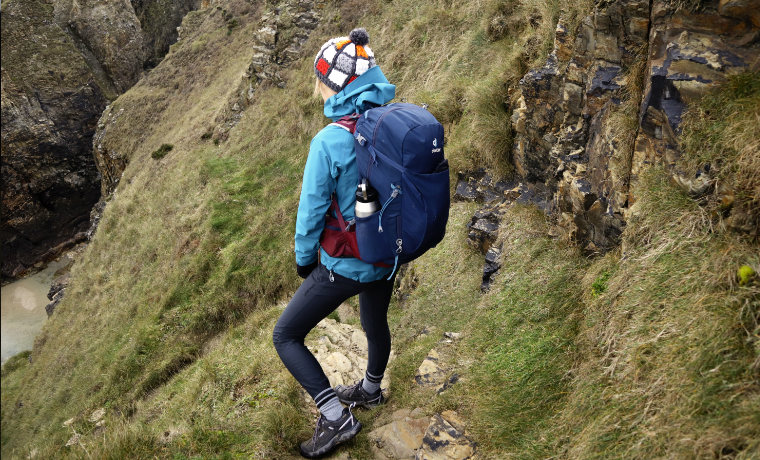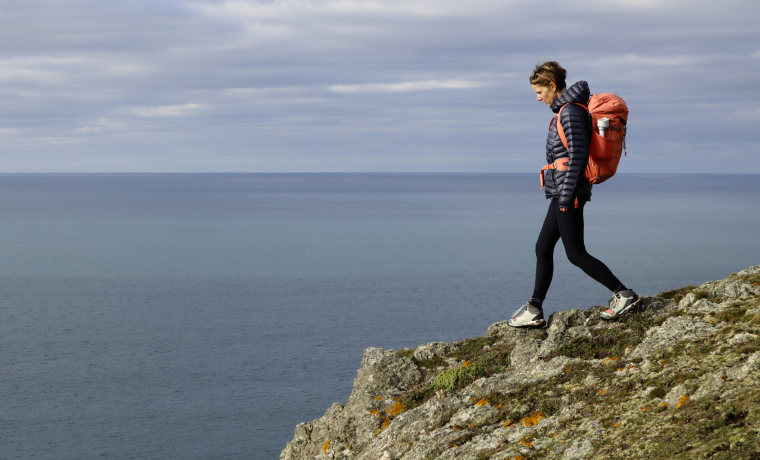Have you ever wondered about the difference between hiking and trekking? Well, wonder (or maybe wander?) no more. We’ve got the answer for you!
But, before we delve into the hiking vs trekking debate, it’s important to stress that the definitions of these two activities are open to some interpretation.
As well as being different, hiking and trekking also share several similarities, which means the terms are somewhat interchangeable. After all, a walk is a walk, is a walk.
So, don’t worry too much if you sometimes call a hike a trek or vice versa. So long as YOU know what you’re talking about, it’s all good.
Now that’s cleared up, let’s take a look at some hiking and trekking differences so you can decide which one is right for you.
- What is hiking?
- What is trekking?
- Hiking vs trekking: benefits
- Hiking vs trekking: equipment
- Hiking vs trekking: pros and cons
- Hiking vs trekking: which one should you do?
- Hiking vs trekking: the final verdict
What is hiking?
Been invited to go for a hike? Lucky you! But, what should you expect on your hiking adventure?
The Oxford English Dictionary definition of hiking is “the activity of going for long walks in the country for pleasure.”
Hiking is something of an Americanism and is what we Brits used to call rambling. It’s usually a walk that takes you out into the countryside so you can commune with nature and enjoy some fresh air and exercise. Hikes often follow so-called nature trails.
Hiking is the activity of going for long walks in the country for pleasure.
That said, you could also go for a lengthy walk around a town or city, which could be described as an urban hike.
Hikes usually follow well-established and even traditional routes and are often well marked, so navigation is easy. Depending on your chosen hike, you may not even need a map, compass, or GPS. Just follow the signs. Hikes also tend to start and finish at convenient locations, such as a car park. The start of a hike is called a trailhead.
Hikes can be short, take just a couple of hours to complete, and are suitable for all ages and levels of fitness.
However, some hikes are longer, considerably more challenging, and best left to fitter or more experienced walkers. For example, there are hikes where you start at dawn and hope to finish by dusk, known as a day hike, while others may require an overnight stop.
That said, depending on your walking speed, one person’s day hike could be an overnighter for others. However, even multi-day hikes should not be a serious undertaking and should be within the grasp of most reasonably fit and capable walkers.

So, to summarise:
- Hikes typically follow known/established trails which are often marked
- Hikes can be long or short
- Many hikes can be completed in one day but may involve an overnight stop
- Most hikes start and end somewhere that’s easily accessible
What is trekking?
According to our trusty Oxford English Dictionary, a trek is defined as “a long, hard walk lasting several days or weeks, especially in the mountains.” The word trek actually comes from the ancient Afrikaans’ word for “migration.”
With more than a few nights on the trail, trekking typically involves carrying all your supplies on your back, including food, water, shelter, etc. You’ll sleep in a tent or bivi or, depending on the region, may find yourself overnighting in refuges or shelters.
You’ll need to be prepared for all eventualities when trekking. For example, you may experience the full range of weather conditions, from heat to rain to snow – especially in mountainous regions. You may also find yourself many miles or days from water or food.
A trek is a long, hard walk lasting several days or weeks, especially in the mountains.
Walking further and the weight of the extra gear makes trekking more physically demanding than hiking. You may even need to spend several months training to ensure you are fit enough for your trek.
Treks can follow established trails but are just as likely to be unmarked routes, so the ability to navigate is essential. A trek may even involve an element of exploration, especially if you are heading out into wilder areas.
A trek is a more serious undertaking than a hike. You are more likely to be far from civilisation and solely responsible for your health, safety, and welfare.

To summarise:
- Treks typically involve many days or even weeks of walking
- Some treks follow established routes but could also involve exploration
- Trekking usually involves more navigation than hiking
- You’ll carry all your equipment on your back
- You need to be self-sufficient as support and help may be many days away
- Trekking is more challenging than hiking, both in terms of distance and terrain
Hiking vs trekking: benefits
Both hiking and trekking involve getting out and walking in nature. While there are some notable differences (distance and duration being the most obvious), these activities offer some similar benefits.
So, regardless of whether you’re heading out for a leisurely morning’s hike or a month-long trek, these are just some of the benefits of walking you can expect to experience:
- Enjoyment – first and foremost, hiking and trekking should be sources of enjoyment. There may be challenges, such as rugged terrain, fatigue, or navigational difficulties. Still, most of the time you spend walking should be life-affirming and immensely rewarding.
- Improved mental health – walking, especially in nature, can reduce stress and anxiety, improve your mood, boost creativity, and enhance other aspects of your mental health. Head out into the countryside and leave your worries behind.
- Increased fitness – walking of any sort is good for your cardiovascular fitness. Strap on a backpack, and you’ll improve your fitness even more. Higher levels of cardiovascular fitness are inextricably linked to better cardiovascular health. Walking is also a great way to strengthen your legs and core.
- Stronger bones – hiking and trekking are weight-bearing activities that increase bone density and strength. Bone density tends to decrease with age and inactivity and can lead to osteoporosis if left unchecked. Osteoporosis is characterised by weak, porous bones that are prone to fracture.

Hiking vs trekking: equipment
Hiking and trekking equipment are similar. However, because treks are longer and more arduous, trekking equipment needs to be stronger and lighter than it does for a hike. After all, you could be carrying your backpack and its contents for several weeks and not just a couple of days. Weight and reliability matter on a trek.
It’s beyond the scope of this article to discuss all the equipment you’ll need for hiking and trekking, but it is worth mentioning some of the most common items.
Clothing
Make sure your walking wardrobe matches the current weather and environment and whatever you can realistically expect during your upcoming adventure.Think in terms of a base layer, mid-layer, and outer layer, so you can easily regulate your temperature. If you are warm when you start walking, you’ll probably be too hot after a mile or two. Likewise, you’ll soon cool down when you stop, or the wind picks up. And don’t forget rain gear and sun protection – the weather can be very unpredictable. You need to be prepared for all eventualities, especially on longer hikes and treks, where conditions can vary from region to region and as you lose or gain height.
Footwear
A pair of running or trail shoes should be sufficient for short day hikes. But, for longer walks, you’ll probably be more comfortable in walking shoes or lightweight boots. Boots are probably best for long treks. They need to be hardwearing and appropriate for the type of terrain you expect to encounter.Make sure your footwear is comfortable and well broken in before you set off on your hike or trek. Blisters can develop quickly and turn even a short hike into a miserable experience.
Backpack
Whether you’re heading out for a few hours or a month, you’ll need a way to carry your gear. A small daypack will be sufficient for short hikes, or you may only need something like a small hydration pack, with enough space for your water bladder, a couple of snacks, and your first-aid kit.If you are planning a long trek, you’ll need something like a large expedition rucksack with plenty of space for all your essential equipment.Regardless, your backpack should be comfortable as few things can ruin a hike or trek like an ill-fitting daypack or rucksack
Walking poles
A lot of trekkers use walking poles, and they’re increasingly popular with hikers. Walking poles let you use your arms to take some weight off your legs. They also provide extra balance and stability on uneven and hilly terrain.While you may not need walking poles on a short hike, they can be very helpful on a long trek, especially if you are carrying a lot of gear.
Understand the benefits of hiking with poles
First aid kit
Accidents can happen on any walk, so you should always carry a first aid kit. While a small solo-type kit is ideal for day and overnight hikes, something more comprehensive would be better for longer treks.Keep your first aid kit near the top of your pack for easy access in an emergency. Make sure you check and restock your first aid kit before every outing.
Tent
Your tent is your home from home on an overnight hike or multi-day trek. Tents for trekking are usually lighter, stronger and more weatherproof than those designed for hiking. Still, they’re often more expensive, too.Regardless, make sure you practice putting up your tent before using it on the trail. Also, carry a repair kit, as tents can break or be damaged in severe weather.
Navigation
You probably won’t need to be especially map-savvy to follow some of the more popular hikes. That said, you should always know where you are so that, in case of illness or injury, you can call for help. But, if you are going on a longer hike or trek, the ability to navigate is a must.While GPS devices and apps make navigation much easier, they’re not 100% reliable, so it’s always worth carrying (and knowing how to use) a compass and map. That way, if your GPS device fails, you’ll still be able to follow the correct route.
Hiking vs trekking: pros and cons
Now you know a little more about hiking and trekking, you are probably wondering how best to choose between these two activities. Weigh up these hiking and trekking pros and cons to make your decision:
Hiking pros:
- Hiking is ideal for beginners and the less fit
- You only need basic equipment to enjoy hiking
- Hikes can be as short as a few hours or as long as a day or two
- Hiking routes are easy to find, and there are lots of well-established hikes to follow
- Some hikes require no navigational skills
- Hiking is a great family activity
- Hiking is a good form of exercise
- Hiking is an ideal weekend or bank holiday activity
Hiking cons:
- Popular hiking trails can be crowded
- You’ll probably be following a well-known trail
- You may spend more time driving to your hike than actually walking
Trekking pros:
- Trekking provides an opportunity to explore new regions
- Trekking routes are usually less crowded
- Your route tends to be more flexible
- Trekking is a more immersive activity
Trekking cons:
- You need to be reasonably fit to enjoy trekking
- You need good navigational skills for trekking
- Treks generally require more planning than most hikes
- You need more equipment for trekking compared to hiking
- Carrying trekking equipment can be tiring
- Preparing for a trek and the trek itself can be time-consuming
- Depending on duration and location, trekking can be expensive
- Trekking requires the ability to be self-sufficient for longer periods
- Getting to the start of a trek and home again can be challenging (travel, visas, vaccinations, etc.)

Hiking vs trekking: which one should you do?
You’ve probably decided whether you’re a hiker or a trekker, so feel free to skip this section. But, if you are still on the fence regarding hiking vs trekking, this is the sequence of events we suggest you follow.
Think of this as a route to your outdoor enjoyment and success!
If you are new to all this nature walking stuff, hiking is probably the best place to start. Begin with some relatively short hikes to get a feel for walking in the great outdoors. If you enjoy it, start increasing your mileage and gradually build up to some longer day hikes and get a feel for how many miles you can walk in a day.
From there, and if you are enjoying hiking, consider doing a multi-day hike. Beg, borrow, or buy a backpack, tent, sleeping bag, stove, etc., and plan an overnighter, taking care not to walk so far the first day that you are exhausted the next.
It’s always best to underestimate your abilities and feel like you could have done more than have to drag yourself home, wishing that you’d never put on your walking boots in the first place!
If all goes well, try a couple of longer overnight hikes and maybe add a second night out under canvas. This extra night will probably involve carrying more kit and being even more organised regarding food, water, etc., so it’s a good test before embarking on a trek.
Once you know that you enjoy multi-day hiking, you may want to progress to trekking.
You could join an organised trek or plan your own trip. However, despite your successful hikes, it’s best to be conservative and avoid committing to anything too long or technically demanding. The last thing we (or you) want is for your trek to become an unpleasant experience.
Hiking vs trekking: the final verdict
Some treks are also hikes, and some hikes can feel like treks. But, in simple terms, a hike is a relatively easy one or two-day walk, whereas a trek is usually a longer, more serious undertaking that lasts several days, weeks, or even months.
The best one for you is the one that matches your abilities and that you’re going to enjoy. And don’t feel you have to choose between hiking and trekking. You could be a weekend hiker and still enjoy longer trekking holidays when your schedule allows.
Just remember to stay safe, leave no trace, and take lots of photos of your amazing experiences out on the trail.




